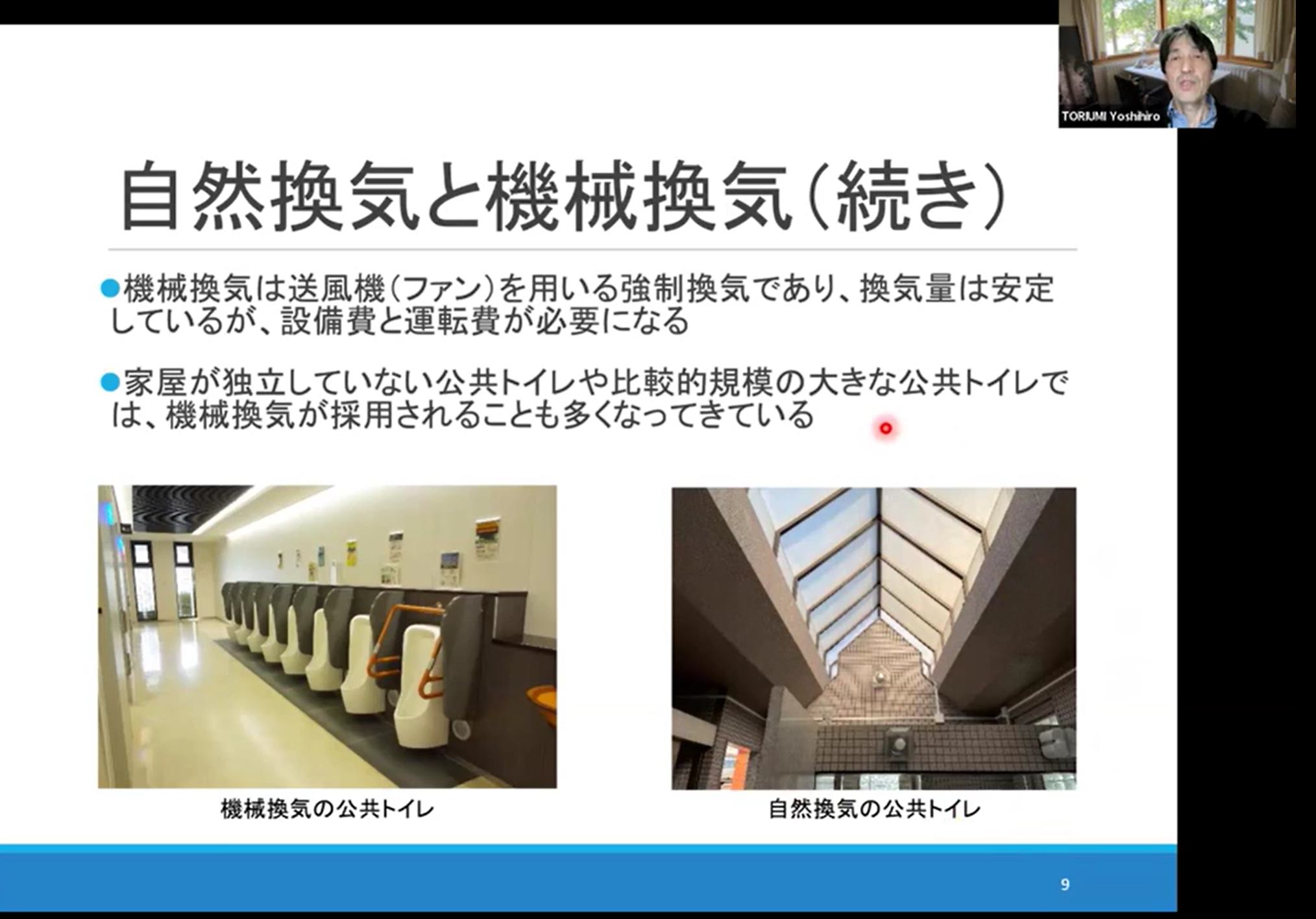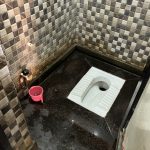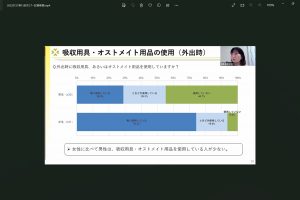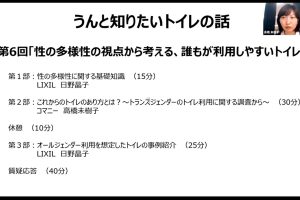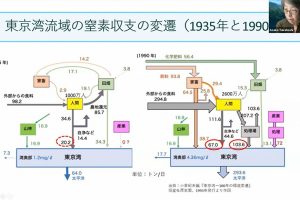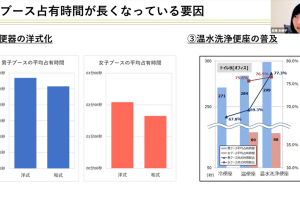The 31st seminar
“Toilet Ventilation Plan with Energy Saving”
Japan Toilet Association (JTA) Seminar Series; “Let us know more about our Toilet Story”
Date: 18 January 2024 (Thu) 18:00-20:00 JST
● Presenter
“Toilet Ventilation Plan with Energy Saving” Prof. Dr. Yoshihiro Toriumi (Department of Architecture and Urban Environment, Faculty of Science and Engineering, Tokyo Denki University)
Toriumi:
Today I will talk about a topic of “Toilet Ventilation Plan with Energy Saving.”
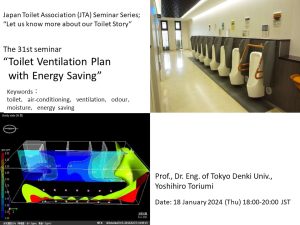
1. Introduction
The toilets will usually generate odours and moisture, and then the ventilation is essential to exchange room air. It is recommended that the toilet room will be ventilated 5 to 15 times per an hour. The ventilation rate is that how many times the room air is replaced in an hour.
However, the mechanical ventilation increases the heating and cooling load in modern commercial facilities where toilets are air conditioned and making it difficult to achieve energy savings consequently. This means it is difficult to achieve both a thermal environment and energy conservation at once.
In this seminar, I will introduce some ways to cut down the ventilation volume to reduce the electricity utility expenses and CO2 emissions.
2. The purpose of the ventilation
The ventilation is to exhaust the pollutants, unnecessary heat, moisture, odours, etc. generated from various resources such as people and the equipment within the room. Then it is necessary to exchange the indoor contaminated room air with fresh air outdoor.
The ventilation is also effective of diluting contaminations. There are a variety of the contaminations. They include the moisture and odour in the toilet room.
We sometimes make a misunderstanding that the circulating the room air is same as the ventilation. It basically means to exchange the indoor air with outdoor one.
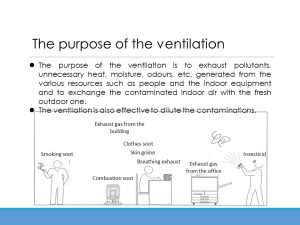
3. The required ventilation frequency of a toilet
First, a required frequency of the ventilation of a toilet room is recommended to be 5 to 15 times if the indoor pollutants are under the permissible value. However, there is quite a variety of the range in fact.
Why is there much ventilation required in a toilet with wide range?
One reason is that it depends on the cleaning conditions. For example, there are some places cleaned a few times a day or once every few days. There is a toilet to be cleaned soon after it gets dirty. There is quite variety in the condition.
Another issue comes from the floor material. For example, when PVC sheet is used to the floor, the floor can be cleaned using a mop, etc. On the other hand, when the porcelain tiles are used for the floor, cleaning is done by sprinkling water and scrubbing with a brush. This method is very likely to generate odours and requires many frequencies of the ventilation. Therefore, it is desirable to adjust the ventilation frequencies depending about the toilet situation.
4. The whole and local ventilation methods of a toilet
The general ventilation means that changes the room air in the entire space of the toilet. Whereas, the local ventilation is to ventilate a part of the house, for instance such as a range hood in the kitchen. Some modern toilets apply the local ventilation methods to boost its efficiency.
For example, when urine spill under urinal, it creates a bad odour. To solve this there is an exhaust vent close to urinal. Some urinal type has the vent within the urinal. The ventilation efficiency will be boosted by the part of the ventilation method.
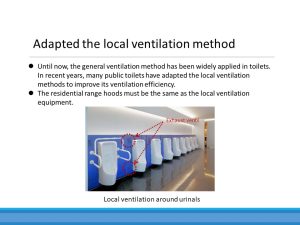
5. An efficient ventilation method
A method with the efficient ventilation includes “A displacement ventilation method”, “A room airflow control method”, and “A local ventilation method.”
The displacement ventilation method applies the buoyancy of the room air due to the temperature differences, and exhausts the room airflow from the exhaust port on the ceiling. The method is to exhaust the room air by means of becoming less dense and rising as the warm temperature.
The room airflow control method boosts the ventilation efficiency by the room airflow from the inlet to the outlet.
The local ventilation method is that immediately sucks up and expels the room air.
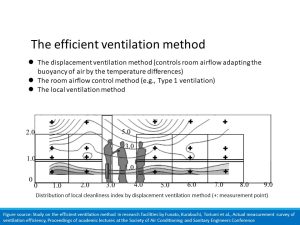
6. Q&A
(Q1: UM)
I have two questions;
Some of our company’s toilets have recently been equipped with the air conditioning. They are designed with a ventilation frequency of 5 times. Those toilets are kept clean by well cleaning. We think we can further reduce the number of the ventilation frequencies in the future by cleaning and increasing the air conditioning efficiency of the local ventilation.
Second, ZEB (Net Zero Energy Building) has recently become prominent in the worldwide. Downsizing of the air conditioning equipment seems to be a method to achieve ZEB. Reducing the number of ventilations must be effective for this purpose. Will downsizing air conditioning equipment contribute to reduce the energy consumption?
(A1: Toriumi)
I am not particularly concerned about the ventilation frequency of 5 times. Some toilets are ventilated at 2.4 times/h. Therefore, when the efficiency improved, it might be acceptable even one-time ventilation.
The reduction of the ventilation frequency depends on the conditions such as the cleaning qualities and ventilation method.
The second question is difficult to answer for me, but when considering ZEB, reducing ventilation frequency would be extremely important. However, as a countermeasure against COVID-19, the ventilation frequencies must increase. To solve this issue, the related researches recommend to boost the ventilation efficiency by applying the filters and air purifiers.
